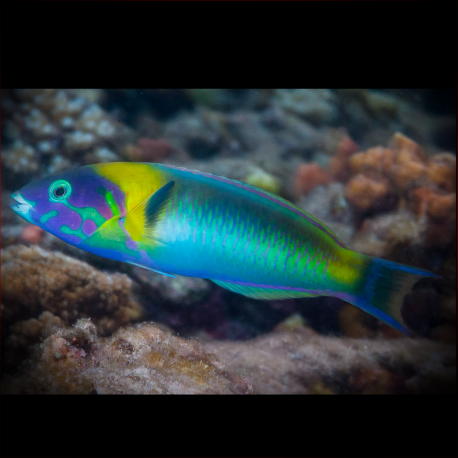More info
Datasheet
| Minimum Tank Size | 800 litres / 211.34 US gallons |
| Maximum Size | 16.0cm / 6.30inches |
| Reef Compatible | Reef safe with caution |
| Temperament | Might be aggressive towards other species |
| Temperature | 22.2°C / 71.96°F - 25.6°C / 78.08°F |
| Specific Gravity | 1.020-1.025 |
| Carbonate Hardness | 8-12 |
| pH | 8.1-8.4 |
General Description
The Thalassoma amblycephalum, commonly known as the Bluntheaded wrasse, is a species belonging to the Labridae family. These wrasses are visually striking both in their juvenile and adult forms. They have a notable size difference as they mature, with stunning colors that add to their beauty. Their diet includes parasites as a common food source, but they also consume a variety of invertebrates such as snails, crustaceans, and sea urchins.
Aquarium Suitability
The Bluntheaded wrasse is deemed suitable for aquariums with caution. However, due to their rapid growth, they require a sizable tank, with a minimum recommended size of 800 liters when fully grown. These fish should be fed multiple times a day to match their high activity levels. They are known to be aggressive towards smaller fish and are capable of jumping out of open aquariums, posing a risk to them.
Care and Hardiness
Considered hardy, these wrasses require diligent care, including frequent feeding and appropriate hiding places within the aquarium. They can be aggressive, especially if lacking sufficient space. With a hermaphroditic nature, they can change gender from female to male as needed, and they may live in pairs consisting of a male and a female. Regular feeding with a varied diet is essential to their well-being.
Reef Suitability
Reef aquaria enthusiasts can include the Bluntheaded wrasse with caution, as they are considered reef safe with careful consideration. However, they may exhibit aggression towards other species and pose a threat to snails and small crustaceans within the reef environment.
Aquarium Setup
Setting up an aquarium for the Bluntheaded wrasse should include ample swimming space and hiding spots, such as live rocks. A sandy substrate, while not mandatory, can provide a suitable environment for them. Maintaining a stable water condition with a pH range of 8.1-8.4, a temperature between 22.2-25.6°C, and a specific gravity of 1.020-1.025 is vital for their well-being.
Behaviour
These wrasses are known to be quite active swimmers, requiring a tank that accommodates their need for open space. They may exhibit aggressive behavior towards other fish, particularly smaller species, as they grow larger in size. Additionally, they have the ability to remove parasites from other fish, contributing to the overall health of the aquatic community.
Feeding and Diet
Their diet consists of larger crustaceans, other invertebrates, small crustaceans, and zooplankton. These wrasses must be fed a varied diet multiple times a day to support their high energy levels and aggressive nature towards smaller marine life forms.
Dimorphism and Captive Reproduction
As hermaphroditic fish, the Bluntheaded wrasse can transition from female to male as needed. They may form pairs within the aquarium environment, consisting of a male and a female wrasse. In captivity, these fish have been known to breed successfully, reproducing within controlled aquatic settings.
Habitat and Distribution
The natural habitat of Thalassoma amblycephalum includes regions in the East Indian Ocean, West Indian Ocean, Australia, Japan, Indonesia, and parts of the East Pacific and Central/West Pacific. They are commonly found in reefs, where they play a role in controlling populations of unwanted invertebrates like flatworms and pyramid snails.

